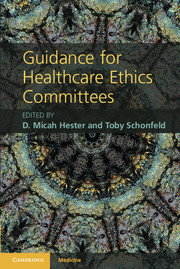Book contents
- Frontmatter
- Contents
- Contributors
- Preface
- Section 1 The Context of Healthcare Ethics Committee Work
- Section 2 Consultation
- 5 Mission, vision, goals: defining the parameters of ethics consultation
- 6 Ethics consultation process
- 7 Informed consent, shared decision-making, and the ethics committee
- 8 Decision-making capacity
- 9 Family dynamics and surrogate decision-making
- 10 Confidentiality
- 11 Advance care planning and end-of-life decision-making
- 12 Medical futility
- 13 Ethical issues in reproduction
- 14 Ethical issues in neonatology
- 15 Ethical issues in pediatrics
- Section 3 Policy Development and Organizational Issues
- Section 4 Educating Others
- Index
- References
12 - Medical futility
Published online by Cambridge University Press: 05 August 2012
- Frontmatter
- Contents
- Contributors
- Preface
- Section 1 The Context of Healthcare Ethics Committee Work
- Section 2 Consultation
- 5 Mission, vision, goals: defining the parameters of ethics consultation
- 6 Ethics consultation process
- 7 Informed consent, shared decision-making, and the ethics committee
- 8 Decision-making capacity
- 9 Family dynamics and surrogate decision-making
- 10 Confidentiality
- 11 Advance care planning and end-of-life decision-making
- 12 Medical futility
- 13 Ethical issues in reproduction
- 14 Ethical issues in neonatology
- 15 Ethical issues in pediatrics
- Section 3 Policy Development and Organizational Issues
- Section 4 Educating Others
- Index
- References
Summary
Objectives
Describe the three main deinitions of “medical futility.”
Identify the key factors at the heart of disagreements between surrogates and providers concerning whether a treatment is beneicial.
Distinguish six strategies that ethics committees can use to prevent and to resolve medical futility disputes.
Case
One year ago, 73-year-old Mr. B came to your hospital for surgery on a thymus gland tumor. While the surgery was successful, during his post-operative recovery, Mr. B’s endotracheal tube became dislodged. This resulted in severe, irreversible brain damage. Mr. B was subsequently discharged to other facilities. But, 6 months ago, he was readmitted to your hospital with a diagnosis of renal failure. He has remained there ever since, in a persistent vegetative state, dependent for survival on mechanical ventilation, hemodialysis, and tube feedings. Mr. B has developed increasingly severe decubitus ulcers and recurrent infections. He remains a full code.
In light of his deteriorating status, Mr. B’s physicians have determined that he is beyond medical rescue. They think that it is medically inappropriate and outside the standard of care to continue his life-sustaining treatment. Indeed, they think it is ethically inappropriate and inhumane to sustain Mr. B artificially while his body is decomposing.
The treatment team wants to discontinue dialysis and issue a DNAR order. They have carefully explained their proposed treatment plan to Mr. B’s surrogate, his daughter. But, even after many conferences, she will not consent. Mr. B’s family is very close. Discussion with his wife and sons confirms that the surrogate is acting in accordance with Mr. B’s consistent, considered, and deliberated preferences. The hospital tried to transfer Mr. B to another facility willing to provide the disputed treatment, but none could be found. Mr. B’s attending physician has sought guidance from the ethics committee.
- Type
- Chapter
- Information
- Guidance for Healthcare Ethics Committees , pp. 88 - 97Publisher: Cambridge University PressPrint publication year: 2012
References
- 6
- Cited by



